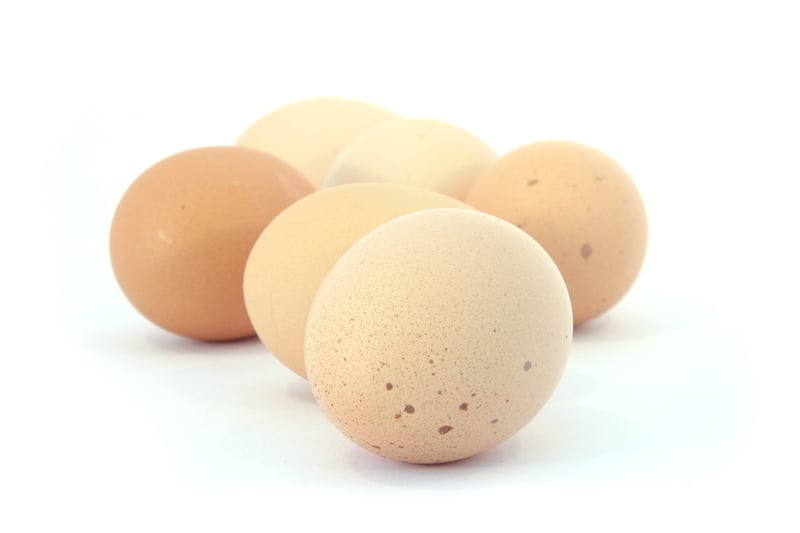Cage-Free vs. Free-Range vs. Pasture Eggs: What’s Best?

Do you ever stand in front of the egg section at your local grocery store and get overwhelmed by all of the choices available? You’re not alone! First, there’s regular, large, extra-large, and jumbo options. Then, there’s terms like grade A, organic, barn, fertile—what do those even mean? On top of that, you’ve got to choose from brown, white, and sometimes even blue or green eggs. What about cage-free vs. free-range vs. pasture-raised eggs? The only thing these terms have in common is that they’re all confusing… Is there a difference? And if so, which type of egg is best?
This can be a tough shell to crack, as they do all sound pretty darn alike. Wouldn’t a free-range chicken be cage-free, and vice versa? And wouldn’t that mean they’re out running in a pasture, with the wind fluffing their feathers as they gobble up grasses and tasty insects?
Unscrambling the Egg Terms
How the average person may describe a chicken (and thus their eggs), however, appears to differ drastically from a producer or government official. The terms cage-free vs. free-range are used only to define the different types of production for eggs.
Let’s take a peek into the henhouse to discover what these terms technically mean.
Cage-Free Eggs
Cage-free is defined by the USDA as, “laid by hens that are able to roam vertically and horizontally in indoor houses and have access to fresh food and water. Cage-free systems vary from farm to farm and can include multi-tier aviaries. They must allow hens to exhibit natural behaviors and include enrichments, such as scratch areas, perches, and nests. Hens must have access to litter, protection from predators, and be able to move in a barn in a manner that promotes bird welfare.” 1
This doesn’t really match the image many of us have for cage-free, as there are no requirements for how spacious their quarters are—and thus, they’re often pretty cramped. Basically, chickens are kept “safe” in a barn, but at least they have access to fresh food and water as well as perches and nests, so they can exhibit more of their natural behaviors.
On the other hand, as there are no requirements for lighting or air-flow, cage-free hens can also be exposed to poor air quality. In addition, they tend to have increased mortality rates (partially as the breed of chickens in these farms have shorter lifespans and partly because their close quarters often leads to quarrels among the birds, which can lead to hens getting hurt or even killed). Even though they don’t live in cages, the birds (20,000 – 40,000 of them) can still be crammed in a barn, effectively unable to move, without any access to the outdoors.
Free-Range Eggs
Free-range sounds as if chickens are running free through pastures, chasing insects, and living naturally. How accurate is that? According to the USDA, free-range chickens are provided the same environments as cage-free chickens PLUS “Continuous access to the outdoors during their laying cycle.” Their outdoor playground can be fenced or covered, but they have access to sunlight. 1
Does that mean the chickens have the chance to bask in sunlight? Nope. They have access to the great outdoors, but they may never actually see the light of day, as chickens are naturally cautious creatures. Their outdoor “playground” may also just be a concrete porch, which isn’t nearly as enticing as clean grass or dirt.
The bottom line is that “free-range” poultry have access to as little as 2 square feet of outdoor area per bird…but that doesn’t mean that the birds ever see the outdoors. Often, free-range chickens are still crammed in a barn with one small point of access to the outside.
Organic Eggs
Organic eggs come from birds that are typically free-range and are also fed organic diets that are free from pesticides and antibiotics. However, organic says nothing about the environment, which can differ dramatically from producer to producer, in which the birds are raised. While it’s nice to presume organic eggs come from chickens raised in a more natural habit, that is not always the case.
Pasture-Raised Eggs
Pasture-raised, a phrase that is not defined or regulated by the USDA but rather by a third-party certification program, actually does come closer to matching the picture of how chickens might actually live and roam, if they had their druthers, that is. According to the Humane Society, pasture-raised birds are set out to pasture for at least six hours a day, where they can frolic in the sunshine, peck and scratch with abandon, and enjoy a more natural environment. They’re then brought inside at night to help keep them protected from predators and weather.
Again, this designation is not regulated by the USDA, but rather, it comes from the Humane Farm Animal Care (HFAC), 2 and it’s as close as you can come to the pleasant country life you likely imagined from the terms above. Do be aware, however, that you need to watch for the certification specifically from HFAC, as brands can pop the words on the label, even though they aren’t certified, since the term isn’t regulated. Generally speaking, the HFAC requires that chickens have at least 108 square feet (per bird) of outdoor roaming space for their eggs to earn the pasture-raised designation.
Conventional Eggs
What about the ubiquitous and affordable conventional eggs found at every grocery store? On conventional farms, around eight chickens are typically kept in a cage with a sloped floor. The separate cages allow the farmers to protect their hens from predators, and it also gives them a better opportunity to watch for parasites or other potential problems.
Sadly, the hens are then not allowed to act like chickens. They have no room to walk, forage, or even flap their wings, stretch, or shake their tail feathers. Generally speaking, these birds only have about 67 – 86 square inches (per bird) of space to move around (in a cage). They also can’t dust bathe, nest, or roost, which are natural chicken behaviors. They also find it more difficult to lay eggs as hens tend to look for privacy to lay. Finally, the hens are susceptible to injury by being trapped in wires or getting their feet caught due to overgrown claws.
Some farmers provide “enriched”, or furnished, cages, which provide perches, nesting boxes, and scratching areas, allowing a bit more room for more natural chicken behavior. Yet, the hens still don’t have access to sunlight or the outdoors.

Additional Egg Designations
According to the USDA, cage-free vs. free-range vs. pasture eggs only indicate the environment the laying eggs live in. It doesn’t provide any information about nutritional differences. That said, we think it’s important that the animals we depend on for food also enjoy quality of life.
Along those lines, commercial egg producers—who produce something like 95% of the eggs found at grocery stores—aren’t required to provide any freedom or space. Millions of chickens live their entire lives in spaces that are less than the size of a sheet of paper—with no access to engage in normal, natural chicken behaviors. 2,3 And as many as 100,000 chickens can be shoved together into a single barn (or, more accurately, warehouse). 3
SPECIAL OFFER: Ageless Turmeric Supports Healthy Inflammation Levels & Detoxification. Now Up to 71% Off.
In addition, most producers remove parts of the beaks from chicks when they’re days old and may even starve the birds to encourage the loss of feathers (or molting), which manipulates their laying cycle. That’s pretty heartbreaking.
With that in mind, there are other label certifications to look for if you’re interested in supporting farms that emphasize treating animals humanely. These include:
Animal Welfare Approved provides the highest standards, according to the Humane Society. Flocks are limited to no more than 500 birds, and starvation and beak-cutting are prohibited, as is feeding the birds meat or animal byproducts.
In addition, each hen has access to at least 1.8 square feet and enough room to nest, perch, and dust-bathe. They also have access to at least 4 square feet per bird to the great outdoors (which must also be covered with growing vegetation rather than a concrete porch) to give them the opportunity to forage and range. 2
Certified Humane is run by the Humane Farm Animal Care, which provides three levels of certification. They prohibit forced molting via starvation. However, beak cutting is allowed. For “cage-free” eggs, the birds must be allowed to nest, perch, and dust-bathe, but they can be kept indoors. Free-range birds have access to 2 square feet of outdoor space per bird for at least 6 hours per day. And pasture-raised birds are set to pasture (with at least 108 square feet of living vegetation) for at least 6 hours a day. 2
American Humane Certified also has three levels. While Enriched Colony Cages allow for perching and nesting, farmers are required to provide birds with individual cages that are less than the size of legal-sheet of paper. Cage-free birds get a bit more space, but they’re kept indoors at all times. Free-range chickens get access to the outdoors, but there’s no minimum time required. And while pastured allows for more space, there’s again no minimum time period. 2
Food Alliance Certified also prohibits forced molting, animal byproducts or meat, and it ensures chickens are provided 1.23 square feet each with access to natural daylight or outdoor roaming with living vegetation for at least 8 hours per day. The birds are also able to nest, perch, and dust-bathe. 2
Egg Designations That Mean Nothing
What about the label of “hormone free”? That claim on eggs (and all chicken products for that matter) actually means nothing, as hormones and steroids are already banned by the FDA. What about no added antibiotics? It really means very little also, as the eggs from hens given antibiotics are no longer for human consumption. (Antibiotics are, however, often used in chickens raised for meat.) Other terms that mean nothing: “farm fresh” and “all natural.” Just pretend they aren’t there, as they have no substance or real meaning. 3
Vegetarian diet must mean something, though, right? Maybe, but it’s probably not what you think. Chickens are actually omnivores, and some of their favorite foods include insects, like grubs and grasshoppers. Hens fed “vegetarian diets” are at least not getting “chicken byproducts,” but they may still be eating an unnatural (for them) diet, which includes fortified corn and doesn’t include those insects that chickens prefer.
At least you can determine that the egg is better by the color, right? Nope. The color of the egg just depends on the breed of chicken. There’s really no meaningful difference—nutritionally speaking—between brown, white, and even blue eggs.
How to Choose the Best Eggs
Unfortunately, the designations for eggs is way more complicated than it need be, so to help ensure you’re getting the best eggs from the most humanely treated birds, you may need to combine label claims. For example, if you’re interested in cage-free eggs, go the extra step to ensure they also have Certified Humane status, which means they have more space (1.5 square feet each). For free-range, you’ll also want to look for the Certified Humane designation, which means each bird has access to at least 2 square feet of outdoor space.
Better yet, look beyond the USDA constraints for pasture-raised eggs that are labeled as Certified Humane, which means the chickens were provided with (and encouraged to use) outdoor space that is regularly rotated. This ensures the chickens have plenty of fresh food to pick, but they also can have access to shelter during storms and to protect them from predators.
You will, however, pay a premium price for eggs from pastured chickens. Conventional caged chickens are the cheapest to produce as they use less land and labor. While it differs per area, in general, the more space and the better the environment, the higher costs for the farmers and producers, who pass along some of those costs onto the consumers.
For the humans eating the eggs, there is little data on the difference when it comes to nutritional values. However, pasture-raised eggs may provide higher levels of minerals like magnesium yet be lower in minerals like phosphorus and zinc. 4 Beta-carotene, vitamin A, and vitamin E as well as omega-3 fats, however, have been found to be higher in pasture-raised eggs. 5,6
According to testing from Mother Earth News, hens raised on pasture produce eggs that provide:
- 1/3 less cholesterol
- ¼ less saturated fat
- 2/3 more vitamin A
- 2 times more omega-3 fatty acids
- 3 times more vitamin E
- 7 times more beta-carotene 7
And there is still much we don’t know.
For the animals that create the eggs, on the other hand, there’s a huge difference. Allowing hens access to the great outdoors and the ability to partake in their natural behaviors means that their quality of life and well-being is greatly enhanced.
Now that you know the difference in cage-free vs. free-range vs. pasture-raised eggs, which carton will you choose? Given the information above, we tend to lean toward “Animal Welfare Approved” or at least “Certified Humane.” To take it a step further, the Cornucopia Institute has put together a very helpful Egg Scorecard that ranks 136 different egg producers using a variety of criteria. Another option is to skip the grocery store aisle altogether and find a local source of eggs from your famer’s market or family farmers who share your values.
Of course, once you have made your decision and have your eggs safely at home, now you have to decide how to prepare your eggs: hard-boiled, fried, scrambled, poached… Will the choices around eggs ever end?





 7 Signs Your Body is Seriously Low on Collagen (not just wrinkles)
7 Signs Your Body is Seriously Low on Collagen (not just wrinkles) Health Expert: "Turmeric Doesn't Work (unless...)"
Health Expert: "Turmeric Doesn't Work (unless...)" 3 Warning Signs Your Probiotic Supplement is a Total Waste
3 Warning Signs Your Probiotic Supplement is a Total Waste

